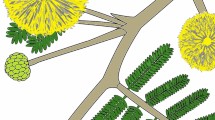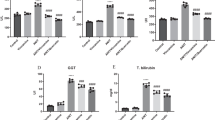Abstract
Purpose
Snail slime is essential in traditional and folkloric medicine, but empirical data on its toxicity is limited. Therefore, the present study assessed rats’ toxicopathology and lipid profile after oral sub-acute exposure to Archachatina marginata slime extracts.
Method
The rats were assigned into five (5) groups (n = 10) and treated for 28 days with distilled water and slime extract (125, 250, and 500 mg/kg bw). In addition, a follow-up group received the snail slime at 500 mg/kg bw and was observed post-administration for 14 days. After the treatment period, the rats were sacrificed, and the blood and vital organs were harvested for biochemical analyses which includes lipid profile, liver and kidney function, oxidative stress indices, and histopathology.
Results
The results revealed that the slime of A. marginata did not remarkably affect the liver and kidney function indices and Castelli’s Risk Index II (CRI-II) was < 3.0 across all groups. However, histopathology showed hepatocellular damage in the female rats, which resolved following the cessation of treatment. Furthermore, there were cellular changes, including mild inflammation and cellular degeneration of rat tissues across the treatment groups.
Conclusion
The findings warrant further safety assessments to bolster the medicinal properties of A. marginata slime.












Similar content being viewed by others
Availability of data and materials
The datasets used and/or analyzed during the current study available from the corresponding author on reasonable request.
References
Ahmad AM, Ali M, Muâ L, Abdallah HMS, Zungum IU (2021) Assessment of antibacterial activity of snail (Archachatina marginata) slime on some clinical wound isolates. Innov Int J Med Pharmaceut Sci 6(2):8–11
Olaolu D, Rotimi DE, Olaolu AP (2018) Effect of alcohol infusion of Cissus populnea root on testicular function and serum hormone of male Wistar rats. Asian Pacific J Reprod 7:117–122. https://doi.org/10.4103/2305-0500.233572
Adhikari PP, Paul SB (2018) History of Indian traditional medicine: a medical inheritance. History 11:1
Bordon KDCF et al (2020) From animal poisons and venoms to medicines: achievements, challenges and perspectives in drug discovery. Front Pharmacol 11:1132
Offiong E et al (2013) Nutritional/chemical constituent of three local species of land snail Archachatina marginata, Achatina achatina and Achatina fulica found in Uyo-Akwa Ibom State. Int J Sci Technol 1:1–5
El Mubarak MAS, Lamari FN, Kontoyannis C (2013) Simultaneous determination of allantoin and glycolic acid in snail mucus and cosmetic creams with high performance liquid chromatography and ultraviolet detection. J Chromatogr A 1322:49–53
Cilia G, Fratini F (2018) Antimicrobial properties of terrestrial snail and slug mucus. J Complement Integr Med 15:3
Zhuang J et al (2015) Identification of candidate antimicrobial peptides derived from abalone hemocyanin. Dev Comp Immunol 49:96–102
Harti AS, Sulisetyawati SD, Murharyati A, Oktariani M, Wijayanti IB (2016) The effectiveness of snail slime and chitosan in wound healing. Int J Pharma Med Biol Sci 5:76
Chinaka N et al (2021) Snail slime: evaluation of anti-inflammatory, phytochemical and antioxidant properties. J Complement Altern Med Res 13:8–13
Matusiewicz M et al (2018) In vitro influence of extracts from snail Helix aspersa Müller on the colon cancer cell line Caco-2. Int J Mol Sci 19:1064
Dolashki A et al (2018) Structure and antibacterial activity of isolated peptides from the mucus of garden snail Cornu aspersum. Bulg Chem Commun C 50:195–200
Kostadinova N et al (2018) Antioxidative screening of fractions from the mucus of garden snail Cornu aspersum. Bul Chem Com 50:176–183
Nwogor UA (2015) Effect of pawpaw (Carica Papaya) and plantain (Musa paradisiaca) leaves on growth performance of Archachatina marginata (African giant land snail). Eur J Biophys 3:23–26
Wiya C, Nantarat N, Saenphet K (2020) Antiinflammatory activity of slime extract from Giant African Snail (Lissachatina fulica). Indian J Pharm Sci 82:499–505
Co-operation, O. f. E. & Development (2008) Test No. 407: repeated dose 28-day oral toxicity study in rodents. OECD Publishing
Guideline OO (2001) 425: acute oral toxicity—up-and-down procedure. OECD Guidelines Test Chem 2:12–16
Gornall AG, Bardawill CJ, David MM (1949) Determination of serum proteins by means of the biuret reaction. J Biol Chem 177:751–766
Wright P, Leathwood P, Plummer D (1972) Enzymes in rat urine: alkaline phosphatase. Enzymologia 42:317–327
Habig WH, Pabst MJ, Jakoby WB (1974) Glutathione S-transferases: the first enzymatic step in mercapturic acid formation. J Biol Chem 249:7130–7139
Adeyemi OS, Sulaiman FA (2012) Biochemical and morphological changes in Trypanosoma brucei brucei-infected rats treated with homidium chloride and diminazene aceturate. J Basic Clin Physiol Pharmacol 23:179–183
Gandhare B, Kavimani S, Rajkapoor B (2013) Acute and subacute toxicity study of methanolic extract of Ceiba pentandra (Linn.) Gaertn. on rats. J Sci Res 5:315–324
Kayode OT, Rotimi DE, Olaolu TD, Adeyemi OS (2020) Ketogenic diet improves and restores redox status and biochemical indices in monosodium glutamate-induced rat testicular toxicity. Biomed Pharmacother 127:110227
Nirogi R, Goyal VK, Jana S, Pandey SK, Gothi A (2014) What suits best for organ weight analysis: review of relationship between organ weight and body/brain weight for rodent toxicity studies. Int J Pharm Sci Res 5:1525–1532
Adeyemi OS, Orekoya BT (2014) Lipid profile and oxidative stress markers in Wistar rats following oral and repeated exposure to fijk herbal mixture. J Toxicol 1–7. https://doi.org/10.1155/2014/876035
Tiwari R et al (2020) An exploratory analysis on the toxicity and safety profile of Polyherbal combination of curcumin, quercetin and rutin. Clin Phytosci 6:1–18
Iyiola OA et al (2019) Cypermethrin and chlorpyrifos raises serum urea level and causes abnormal sperm morphology in Wistar rats. Biointerface Res Appl Chem 9(3):3969–3973
Weiner ID, Mitch WE, Sands JM (2015) Urea and ammonia metabolism and the control of renal nitrogen excretion. Clin J Am Soc Nephrol 10:1444–1458
Gounden V, Bhatt H, Jialal I (2020) Renal function tests. StatPearls Publishing, Treasure Island
Timofte D et al (2021) Dyselectrolytemia-management and implications in hemodialysis. Exp Ther Med 21:1–1
Li L-H, Dutkiewicz EP, Huang Y-C, Zhou H-B, Hsu C-C (2019) Analytical methods for cholesterol quantification. J Food Drug Anal 27:375–386
Danladi JG, Umezuruike GO, Amaechi CC, Haruna GS, Abdullahi MH, Okoh VI (2020) Proximate and mineral composition of snail slime (Archachatina marginata). World J Pharm Pharm Sci 9(11):2304–2512
Amah AK, Ewa O, Karimah MR, Elendu MU, Yunusa Z (2019) Effect of Archachatina marginata mucin on the aggressive factors of gastric ulcer challenged wistar rat stomach tissue. GSC Biol Pharmaceut Sci 9:077–082
Acknowledgements
The authors’ appreciation goes to Landmark University, Nigeria.
Author information
Authors and Affiliations
Contributions
For research articles with several authors, a short paragraph specifying their individual contributions must be provided. The following statements should be used “Conceptualization, OSA, MEB and OJA; methodology, MEB, OSA; software, DER and TCB; validation, OSA and FAO; formal analysis, MEB, OSA and OJA; investigation, MEB; resources, MEB, OJA, OSA and FAO; data curation, DER, TCB and MEB; writing—original draft preparation, MEB, DER, OSA; writing—review and editing, OJA; visualization, OSA; supervision, OSA and OJA; project administration, OSA; funding acquisition, MEB. All authors have read and agreed to the published version of the manuscript.”
Corresponding author
Ethics declarations
Conflict of interest
Morayo Elizabeth Barnabas, Damilare Emmanuel Rotimi, Tobiloba Christiana Elebiyo, Funmilayo Abimbola Okeniyi, Oluwakemi Josephine Awakan, and Oluyomi Stephen Adeyemi declare that we have no conflict of interest.
Ethics approval and consent to participate
The care, use, and treatment of the rats were carried out as described and approved by the Landmark University Ethical Committee. The ethical approval code is LUAC/BCH/2022/004A.
Consent for publication
Not applicable.
Rights and permissions
Springer Nature or its licensor (e.g. a society or other partner) holds exclusive rights to this article under a publishing agreement with the author(s) or other rightsholder(s); author self-archiving of the accepted manuscript version of this article is solely governed by the terms of such publishing agreement and applicable law.
About this article
Cite this article
Barnabas, M.E., Rotimi, D.E., Elebiyo, T.C. et al. Lipid profiling and toxico-pathological assessment of the subacute oral administration of the slime extract of Archachatina marginata in rats. Toxicol. Environ. Health Sci. 15, 127–143 (2023). https://doi.org/10.1007/s13530-022-00166-1
Accepted:
Published:
Issue Date:
DOI: https://doi.org/10.1007/s13530-022-00166-1




